Flexural Strengthening of Reinforced Concrete Beams with Variable Compressive Strength Using Near-Surface Mounted Carbon-Fiber-Reinforced Polymer Strips [NSM-CFRP]
Abstract
1. Introduction
2. Materials and Methods
2.1. Material Properties
2.1.1. Concrete
2.1.2. Steel Reinforcement
2.1.3. Carbon-Fiber-Reinforced Polymer (CFRP) Strips
2.1.4. Epoxy Resin
2.2. Test Specimens
2.2.1. Test Matrix
2.2.2. Beams Geometrical and Reinforcement Details
2.3. Beams Installation
2.3.1. Casting and Curing
2.3.2. Installation of NSM-CFRP Strips
2.4. Test Setup
3. Results and Discussion
3.1. Behavior and Failure Mechanisms
3.2. Failure Modes
3.3. Effect of Concrete Compressive Strength
3.4. Effect of NSM-CFRP Strip Length
3.5. Effect of Number of CFRPs Strips
4. Theoretical Results
4.1. Flexural Strengthening of RC Beams Using NSM-CFRPs Strips
- Step One:
- Computing the design tensile characteristics of CFRPs
- Step Two:
- Computing the concrete properties based on the ACI 318 [46] equations
- Step Three:
- Computing the existing concrete strain on the soffit (εbi)
- Step Four:
- Identifying the bond-depending coefficient of CFRPs (Km)
- Step Five:
- Assuming the depth of the neutral axis (c)
- Step Six:
- Computing the effective concrete and CFRPs strain level (εc, εfe)
- Step Seven:
- Computing the strain in the reinforcement steel (εs)
- Step Eight:
- Computing the stress level in CFRPs strips and reinforcement steel
- Step Nine:
- Computing the internal force and verifying equilibrium
- Step Ten:
- Adjusting c value till reached equilibrium
- Step Eleven:
- Computing the nominal flexure strength (Mn)
4.2. Comparison between Experimental and Theoretical Results
5. Conclusions
- The experimental results confirmed the effectiveness of using the internally bonded NSM-CFRP strips as a strengthening technique. The results showed an enhancement in the flexural capacity of the strengthened RC beams between 10.36% and 52.28%.
- The CFRP strip number considerably affected the flexural load-carrying capacities for beams with medium concrete strength. Strengthening using two horizontal NSM strips showed better ultimate load values compared to that of only one horizontal strip of 35.67% and 30%, respectively.
- The two horizontal NSM-CFRP strips embedded along the entire span length, rather than the area of the maximum moment, had a significant effect on increasing the flexural strength for the tested concrete compressive strength values such that the beams (SM-1) and (SL-1) gained, respectively, 10.94% and 28.01% ultimate load higher than beams (SM-2) and (SL-2).
- The ACI 440.2R guide is conservative in predicting the ultimate flexural capacity since all the experimental results gave a higher ultimate load capacity than the theoretical results. The ratio between the experimental and theoretical results was less than one. Strengthening with one horizontal CFRP strip was the most conservative, followed by the two horizontal strips embedded along the entire span length and the two horizontal CFRP strips at the middle half of the span.
- Compared to the medium compressive strength, better enhancement ratios were recorded in beams with two horizontal CFRP strips along the entire span length and cast with low concrete strength value. The enhancement ratios were 52.28% and 35.67% for the low and medium compressive strengths, respectively.
- Relative to the reference beam, the use of two horizontal NSM strips along the middle length and one horizontal strip along the entire span length had a better enhancement ratio in the medium compressive strength of 22.29% and 30%, respectively, compared to the high compressive strength of 10.72% and 10.36%.
- The improvement ratio in between the schemes approaches each other when the concrete compressive strength is increased. So, the difference in the schemes in high-concrete strength does not give a significant difference. The difference between the SH-2 and SH-3 enhancement ratios was about 0.37%.
- A good confirmation was noted in the experimental and theoretical results using the ACI 440.2 guideline, where the percent reduction was in the range of 19–28%.
- Recommendations and Future Work
Author Contributions
Funding
Institutional Review Board Statement
Informed Consent Statement
Data Availability Statement
Acknowledgments
Conflicts of Interest
References
- El-Gamal, S.; Al-Nuaimi, A.; Al-Saidy, A.; Al-Lawati, A. Efficiency of near surface mounted technique using fiber reinforced polymers for the flexural strengthening of RC beams. Constr. Build. Mater. 2016, 118, 52–62. [Google Scholar] [CrossRef]
- Ibrahim, M.; Wakjira, T.; Ebead, U. Shear strengthening of reinforced concrete deep beams using near-surface mounted hybrid carbon/glass fibre reinforced polymer strips. Eng. Struct. 2020, 210, 110412. [Google Scholar] [CrossRef]
- Heiza, K.; Nabil, A.; Meleka, N.; Tayel, M. State-of-the Art Review: Strengthening of Reinforced Concrete Structures–Different Strengthening Techniques. Int. Conf. Nano-Technol. Constr. 2014, 1, 1–24. [Google Scholar]
- Abdel-Jaber, M. Influence of Externally Bonded CFRP on the Shear Behavior of Strengthened and Rehabilitated Reinforced Concrete T-Beams Containing Shear Stirrups. Fibers 2021, 9, 87. [Google Scholar] [CrossRef]
- Aykac, S.; Kalkan, I.; Aykac, B.; Karahan, S.; Kayar, S. Strengthening and Repair of Reinforced Concrete Beams Using External Steel Plates. J. Struct. Eng. 2013, 139, 929–939. [Google Scholar] [CrossRef]
- Yang, J.; Haghani, R.; Blanksvärd, T.; Lundgren, K. Experimental study of FRP-strengthened concrete beams with corroded reinforcement. Constr. Build. Mater. 2021, 301, 124076. [Google Scholar] [CrossRef]
- Abdel-Jaber, M.; Abdel-Jaber, M.; Katkhuda, H.; Shatarat, N.; El-Nimri, R. Influence of Compressive Strength of Concrete on Shear Strengthening of Reinforced Concrete Beams with Near Surface Mounted Carbon Fiber-Reinforced Polymer. Buildings 2021, 11, 563. [Google Scholar] [CrossRef]
- Hu, B.; Zhou, Y.; Xing, F.; Sui, L.; Luo, M. Experimental and theoretical investigation on the hybrid CFRP-ECC flexural strengthening of RC beams with corroded longitudinal reinforcement. Eng. Struct. 2019, 200, 109717. [Google Scholar] [CrossRef]
- Masoud, S.; Soudki, K.; Topper, T. CFRP-Strengthened and Corroded RC Beams under Monotonic and Fatigue Loads. J. Compos. Constr. 2001, 5, 228–236. [Google Scholar] [CrossRef]
- Shehata, I.A.E.M.; Shehata, L.D.C.D.; Santos, E.W.F.; Simões, M.L.D.F. Strengthening of reinforced concrete beams in flexure by partial jacketing. Mater. Struct. 2008, 42, 495–504. [Google Scholar] [CrossRef]
- Mehdi, S. Flexural Strengthening of RC Columns with Low Longitudinal Steel Ratio using GFRP Bars. Int. J. Concr. Struct. Mater. 2019, 13, 42. [Google Scholar]
- Xing, G.; Ozbulut, O.E.; Al-Dhabyani, M.A.; Chang, Z.; Daghash, S.M. Enhancing flexural capacity of RC columns through near surface mounted SMA and CFRP bars. J. Compos. Mater. 2020, 54, 4661–4676. [Google Scholar] [CrossRef]
- Husain, M.; Eisa, A.S.; Hegazy, M.M. Strengthening of reinforced concrete shear walls with openings using carbon fi-ber-reinforced polymers. Int. J. Adv. Struct. Eng. 2019, 11, 129–150. [Google Scholar] [CrossRef]
- Siddika, A.; Al Mamun, A.; Ferdous, W.; Alyousef, R. Performances, challenges and opportunities in strengthening reinforced concrete structures by using FRPs—A state-of-the-art review. Eng. Fail. Anal. 2020, 111, 104480. [Google Scholar] [CrossRef]
- Wang, Q.; Li, T.; Zhu, H.; Su, W.; Hu, X. Bond enhancement for NSM FRP bars in concrete using different anchorage systems. Constr. Build. Mater. 2020, 246, 118316. [Google Scholar] [CrossRef]
- Alexander, M.; Beushausen, H. Durability, service life prediction, and modelling for reinforced concrete structures—Review and critique. Cem. Concr. Res. 2019, 122, 17–29. [Google Scholar] [CrossRef]
- Viswanathan, G.; Oviya, G.; Priyadharshini, A.S.; Santhiya, K.R.; Yuvasri, M. Experimental Study on Strengthening of RC Beam using Fiber Wrapping. Int. J. Adv. Res. Innov. 2019, 6, 2347–3258. [Google Scholar]
- Nerilli, F.; Vairo, G. Strengthening of reinforced concrete beams with basalt-based FRP sheets: An analytical assessment. AIP Conf. Proc. 2016, 1738, 270016. [Google Scholar] [CrossRef]
- Abdel-Jaber, M.S.; Shatanawi, A.S.; Abdel-Jaber, M. Guidelines for Shear Strengthening of Beams Using Carbon Fiber-Reinforced Polymer (FRP) Plates. Jordan J. Civ. Eng. 2007, 1, 327–335. [Google Scholar]
- Kadhim, M.M.A.; Adheem, A.H.; Jawdhari, A.R. Nonlinear Finite Element Modelling and Parametric Analysis of Shear Strengthening RC T-Beams with NSM CFRP Technique. Int. J. Civ. Eng. 2019, 17, 1295–1306. [Google Scholar] [CrossRef]
- Abed, D.J.; Abdel-Jaber, M.S.; Shatarat, N.K. Behavior of Square Reinforced Concrete Columns Strengthened with Carbon Fiber Reinforced Polymers (CFRP) under Eccentric Loading. Int. J. Civ. Eng. 2018, 9, 532–547. [Google Scholar]
- Al-Ghanem, H.; Al-Asi, A.; Abdel-Jaber, M.; Alqam, M. Shear and Flexural Behavior of Reinforced Concrete Deep Beams Strengthened with CFRP Composites. Mod. Appl. Sci. 2017, 11, 110. [Google Scholar] [CrossRef][Green Version]
- Ashour, A.; El-Refaie, S.; Garrity, S. Flexural strengthening of RC continuous beams using CFRP laminates. Cem. Concr. Compos. 2004, 26, 765–775. [Google Scholar] [CrossRef]
- Fanning, P.J.; Kelly, O. Ultimate Response of RC Beams Strengthened with CFRP Plates. J. Compos. Constr. 2001, 5, 122–127. [Google Scholar] [CrossRef]
- Ge, W.; Tang, R.; Wang, Y.; Zhang, Z.; Sun, C.; Yao, S.; Lu, W. Flexural performance of ECC-concrete composite beams strengthened with carbon fiber sheet. Results Eng. 2022, 13, 100334. [Google Scholar] [CrossRef]
- Maqsood, N.; Rimašauskas, M. Delamination observation occurred during the flexural bending in additively manufactured PLA-short carbon fiber filament reinforced with continuous carbon fiber composite. Results Eng. 2021, 11, 100246. [Google Scholar] [CrossRef]
- Beramly, M.; Jaber, M.A.; Katkhuda, H.; Shatarat, N.; Al-Diseet, M. Shear strengthening and rehabilitating of reinforced concrete T-beams using externally carbon fiber reinforced polymer sheets. J. Appl. Eng. Sci. 2022, 20, 498–510. [Google Scholar] [CrossRef]
- Al-Shamayleh, R.; Al-Saoud, H.; Abdel-Jaber, M.; Alqam, M. Shear and flexural strengthening of reinforced concrete beams with variable compressive strength values using externally bonded carbon fiber plates. Results Eng. 2022, 14, 100427. [Google Scholar] [CrossRef]
- Abdel-Jaber, M.S.; Walker, P.R.; Hutchinson, A.R. Shear strengthening of reinforced concrete beams using different configurations of externally bonded carbon fibre reinforced plates. Mater. Struct. 2003, 36, 291–301. [Google Scholar] [CrossRef]
- Hassan, S.K.H.; Abdel-Jaber, M.S.; Alqam, M. Rehabilitation of Reinforced Concrete Deep Beams Using Carbon Fiber Reinforced Polymers (CFRP). Mod. Appl. Sci. 2018, 12, 179. [Google Scholar] [CrossRef]
- Triantafillou, T.C. Shear Strengthening of Reinforced Concrete Beams Using Epoxy-Bonded FRP Composites. ACI Struct. J. 1998, 95, 107–115. [Google Scholar]
- Chen, J.; Teng, J. Shear capacity of FRP-strengthened RC beams: FRP debonding. Constr. Build. Mater. 2002, 17, 27–41. [Google Scholar] [CrossRef]
- Al-Saadi, N.T.K.; Mohammed, A.; Al-Mahaidi, R.; Sanjayan, J. A state-of-the-art review: Near-surface mounted FRP composites for reinforced concrete structures. Constr. Build. Mater. 2019, 209, 748–769. [Google Scholar] [CrossRef]
- Bilotta, A.; Ceroni, F.; Nigro, E.; Pecce, M. Efficiency of CFRP NSM strips and EBR plates for flexural strengthening of RC beams and loading pattern influence. Compos. Struct. 2015, 124, 163–175. [Google Scholar] [CrossRef]
- Szabó, Z.K.; Balázs, G.L. Near surface mounted FRP reinforcement for strengthening of concrete structures. Period. Polytech. Civ. Eng. 2007, 51, 33–38. [Google Scholar] [CrossRef]
- De Lorenzis, L.; Teng, J.G. Near-surface mounted FRP reinforcement: An emerging technique for strengthening structures. Compos. Part B Eng. 2007, 38, 119–143. [Google Scholar] [CrossRef]
- Nurbaiah, M.N.; Hanizah, A.H.; Nursafarina, A.; Ashikin, M.N. Flexural behaviour of RC beams strengthened With externally bonded (EB) FRP sheets or Near Surface Mounted (NSM) FRP rods method. In Proceedings of the 2010 International Conference on Science and Social Research (CSSR 2010), Kuala Lumpur, Malaysia, 5–7 December 2010; IEEE: Piscataway, NJ, USA, 2011; pp. 1232–1237. [Google Scholar] [CrossRef]
- Kuntal, V.S.; Chellapandian, M.; Prakash, S.S.; Sharma, A. Experimental Study on the Effectiveness of Inorganic Bonding Materials for Near-Surface Mounting Shear Strengthening of Prestressed Concrete Beams. Fibers 2020, 8, 40. [Google Scholar] [CrossRef]
- Chellapandian, M.; Prakash, S.; Sharma, A. Experimental and finite element studies on the flexural behavior of reinforced concrete elements strengthened with hybrid FRP technique. Compos. Struct. 2018, 208, 466–478. [Google Scholar] [CrossRef]
- Strengthening Bridge Slabs with Grouted Reinforcement. ACI J. Proc. 1949, 45, 397–406. [CrossRef]
- Seo, S.-Y.; Feo, L.; Hui, D. Bond strength of near surface-mounted FRP plate for retrofit of concrete structures. Compos. Struct. 2012, 95, 719–727. [Google Scholar] [CrossRef]
- Sharaky, I.; Torres, L.; Sallam, H. Experimental and analytical investigation into the flexural performance of RC beams with partially and fully bonded NSM FRP bars/strips. Compos. Struct. 2014, 122, 113–126. [Google Scholar] [CrossRef]
- Sharaky, I.; Torres, L.; Baena, M.; Miàs, C. An experimental study of different factors affecting the bond of NSM FRP bars in concrete. Compos. Struct. 2013, 99, 350–365. [Google Scholar] [CrossRef]
- ACI 440.2R. Guide for the Design and Construction of Externally Bonded FRP Systems for Strengthening Concrete Structures; American Concrete Institute: Farmington Hills, MI, USA, 2017; p. 116. [Google Scholar]
- Obaidat, Y.T.; Barham, W.S.; Aljarah, A.H. New anchorage technique for NSM-CFRP flexural strengthened RC beam using steel clamped end plate. Constr. Build. Mater. 2020, 263, 120246. [Google Scholar] [CrossRef]
- ACI Committee 318. Building Code Requirement for Structural Concrete (ACI 318M-19); American Concrete Institute: Farmington Hills, MI, USA, 2019. [Google Scholar]
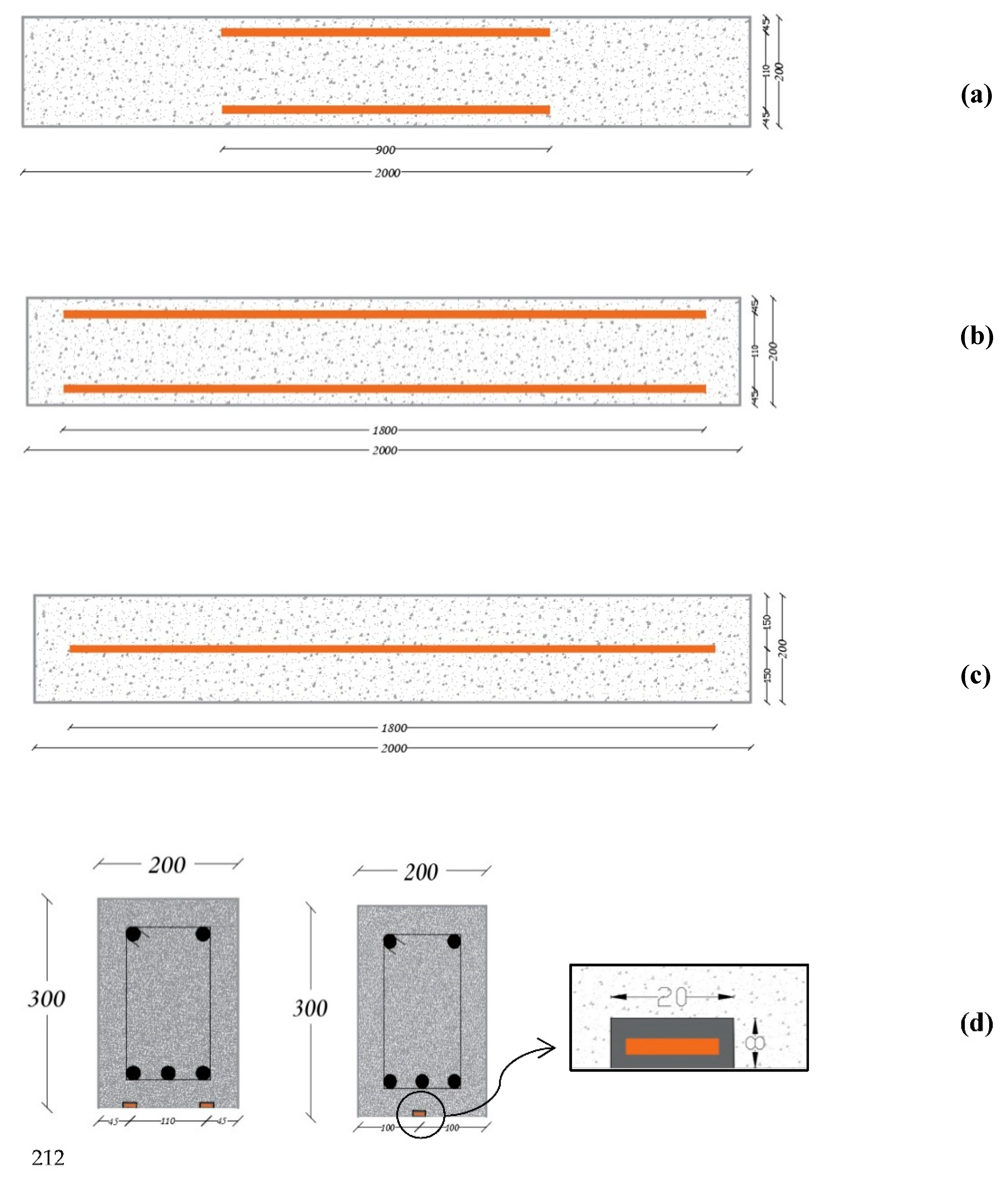


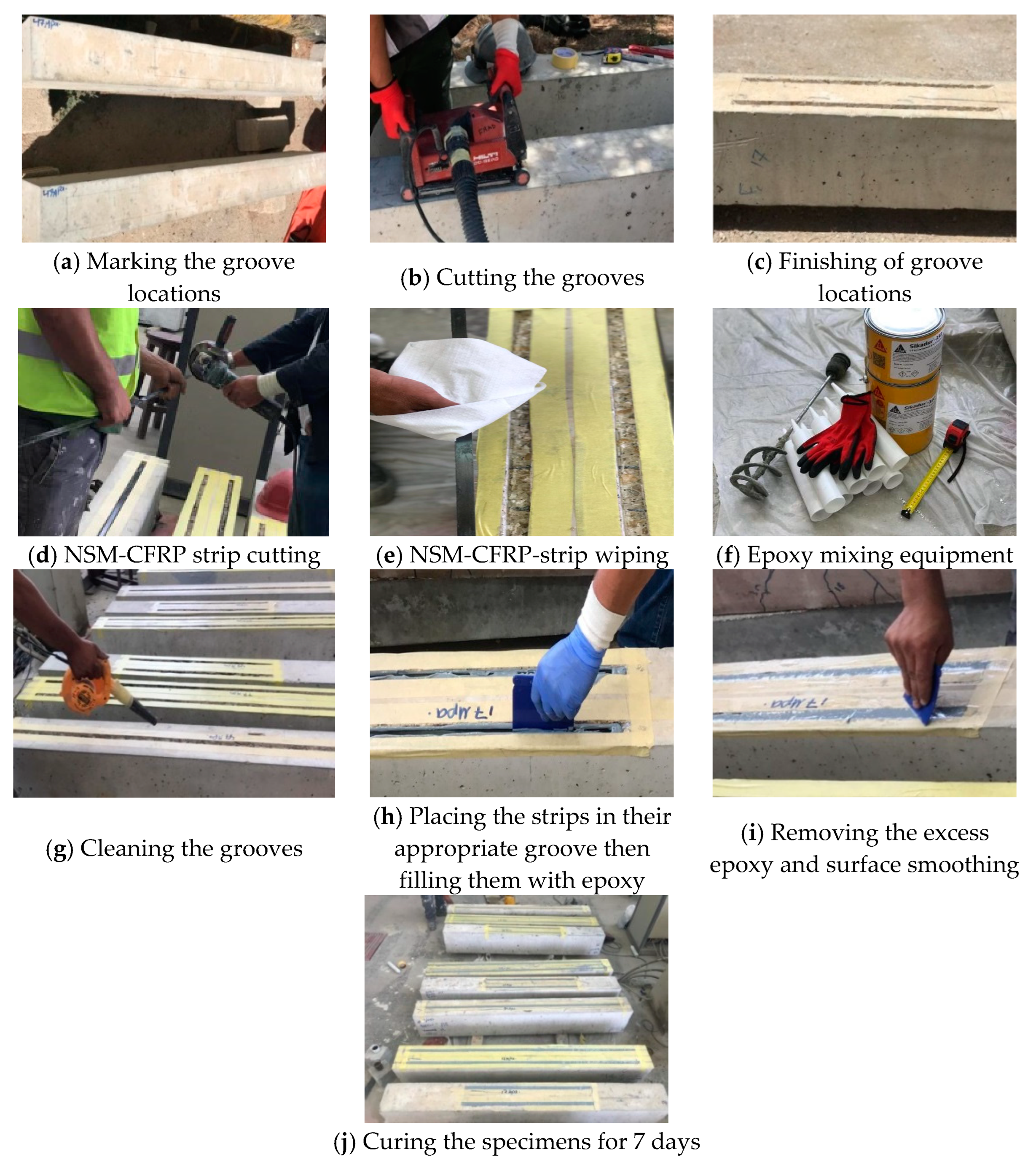
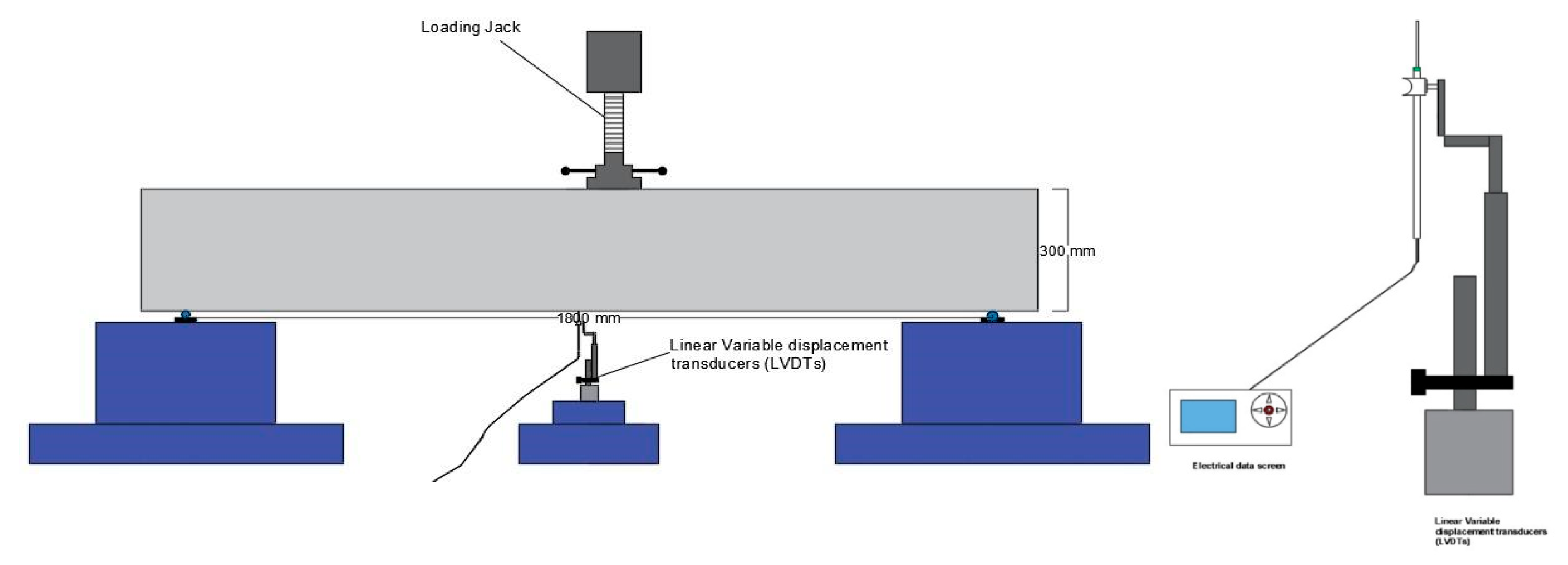

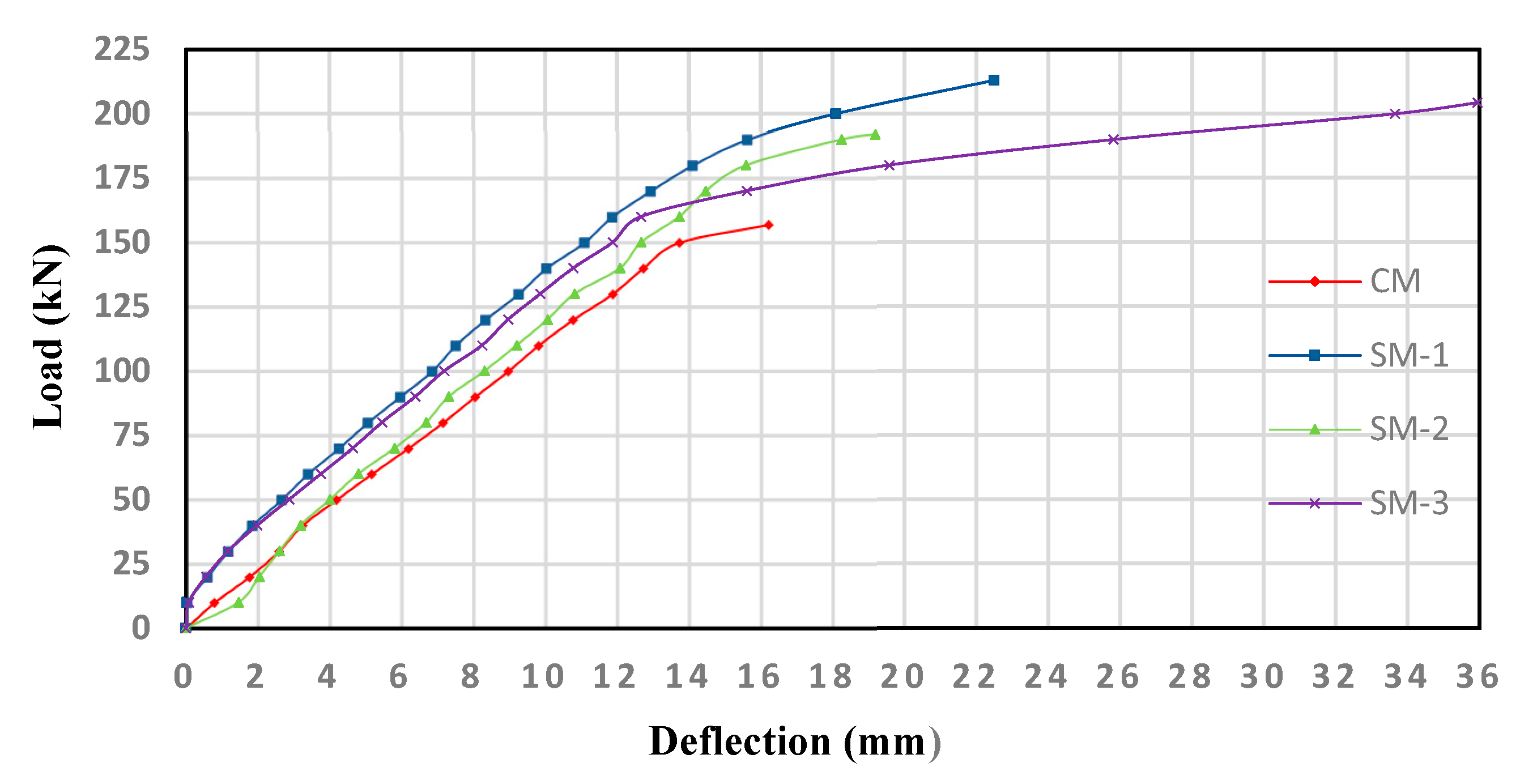


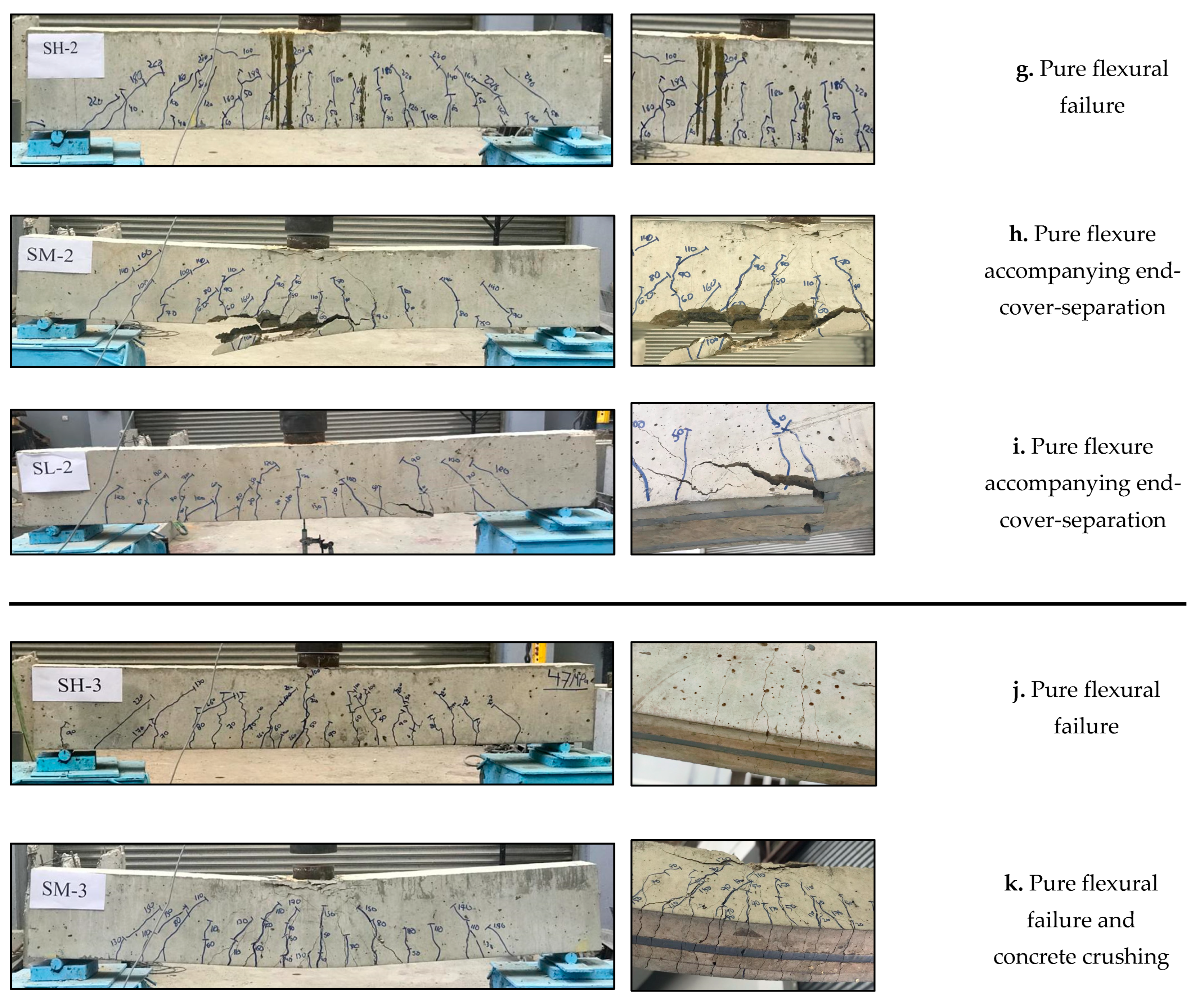
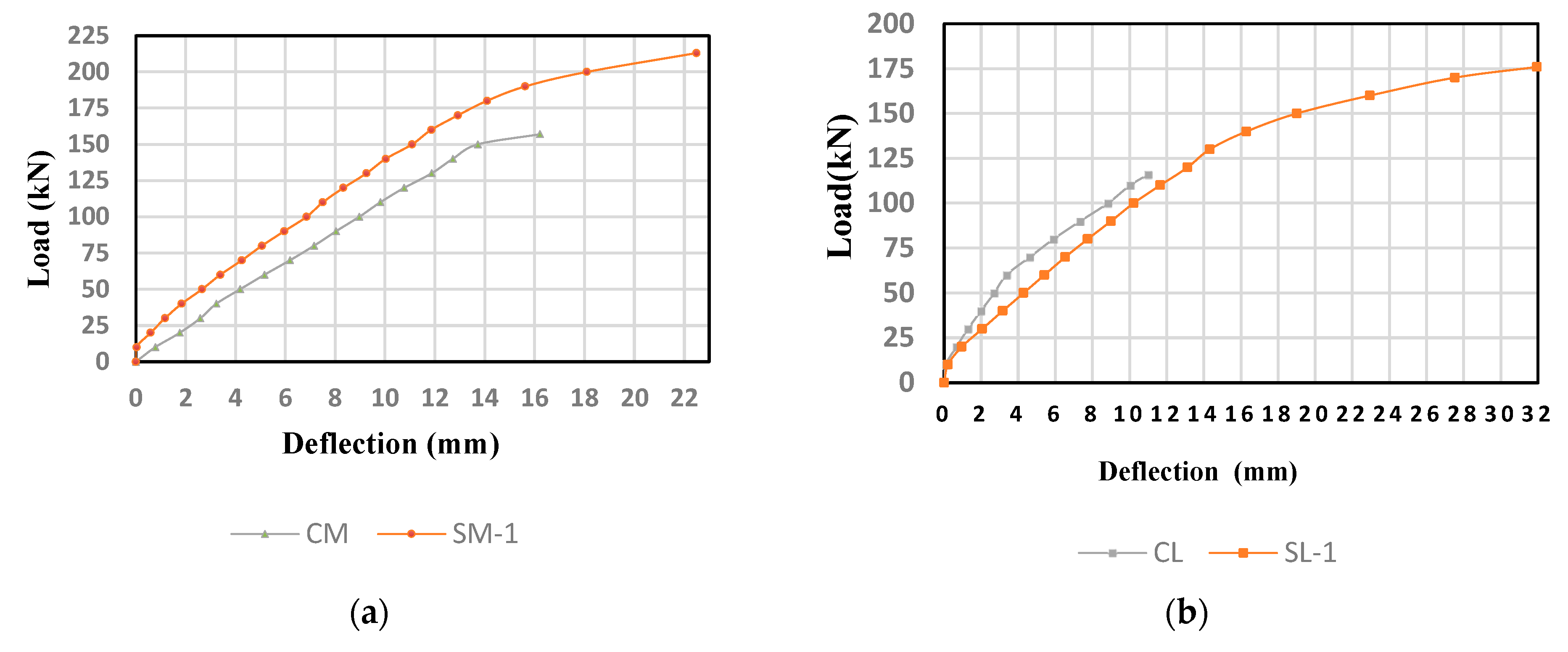
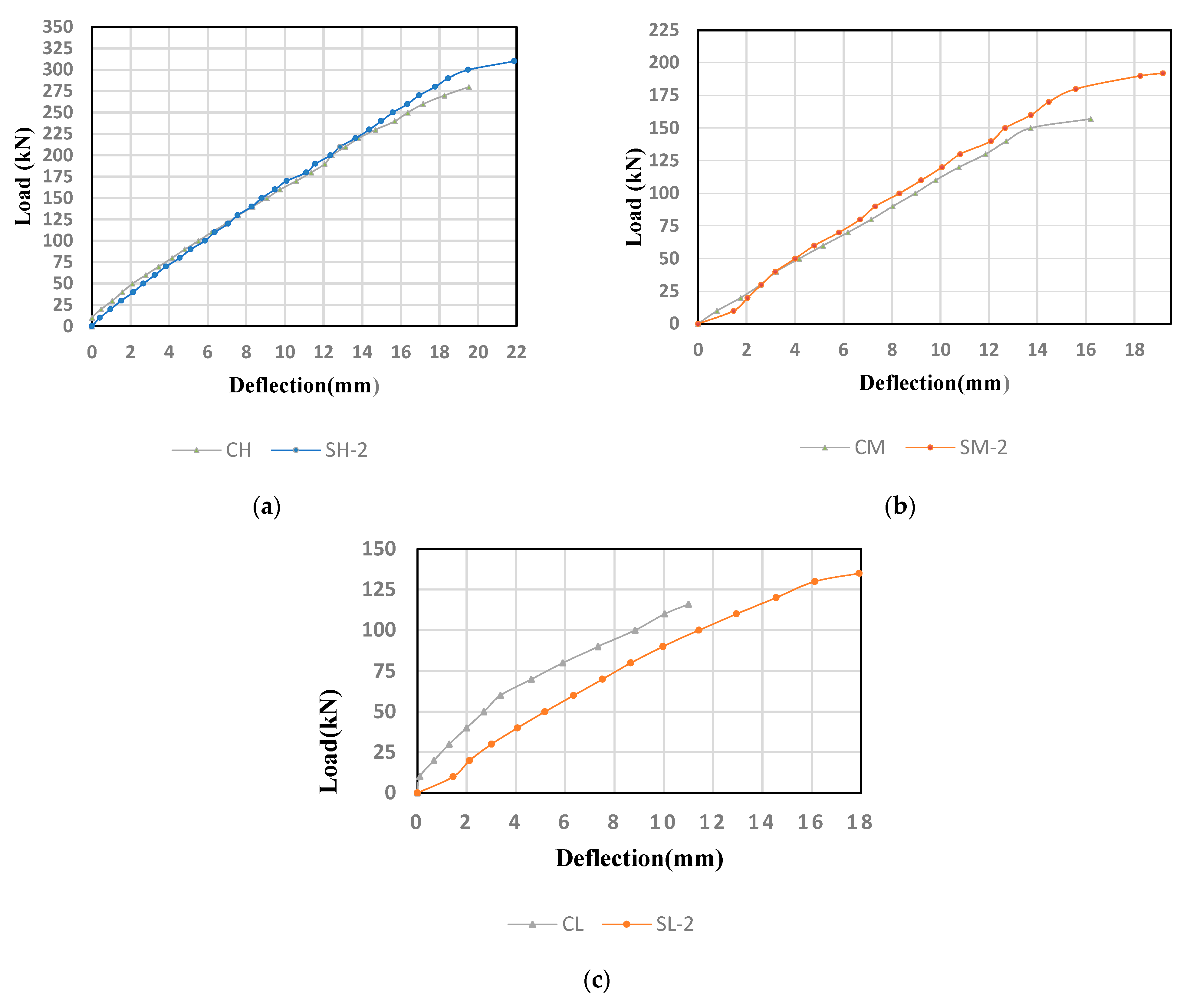
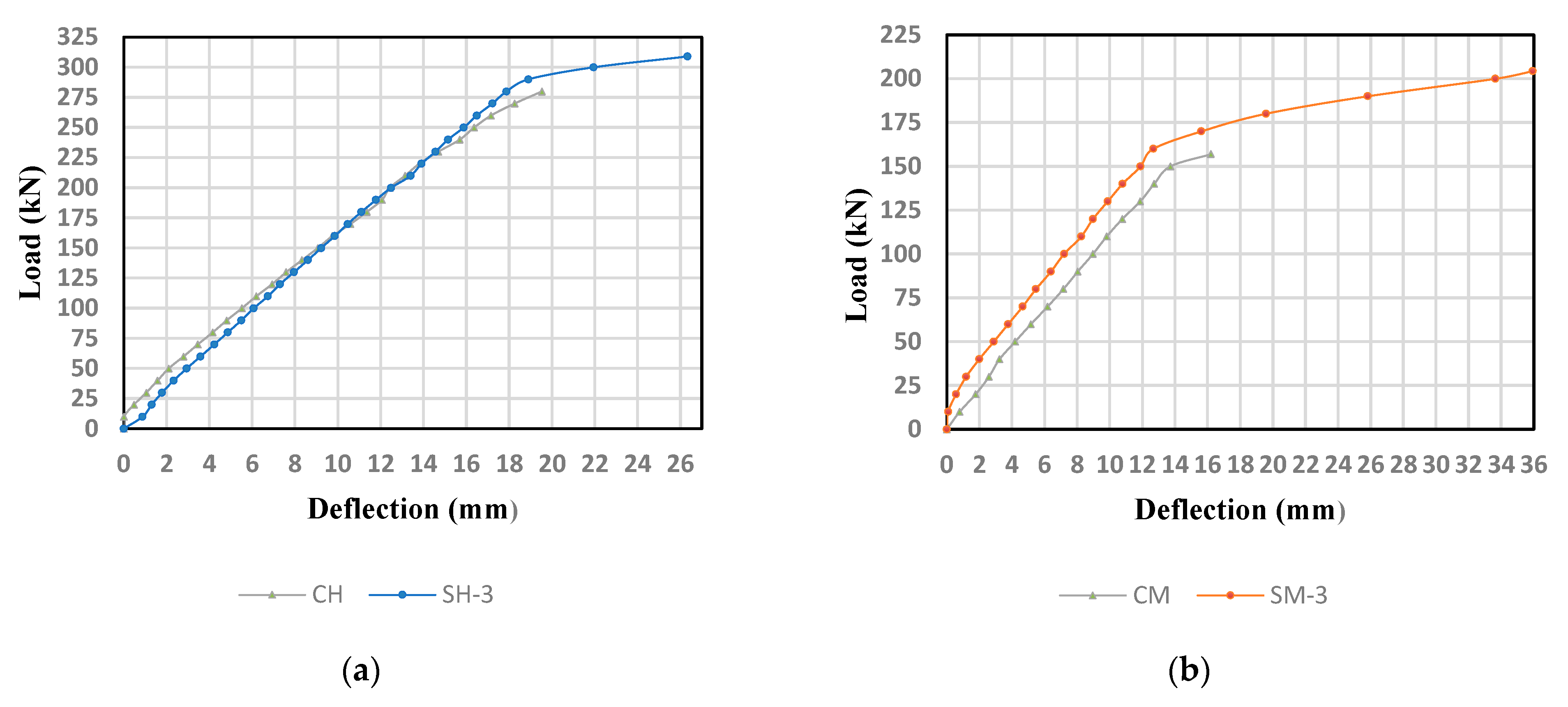
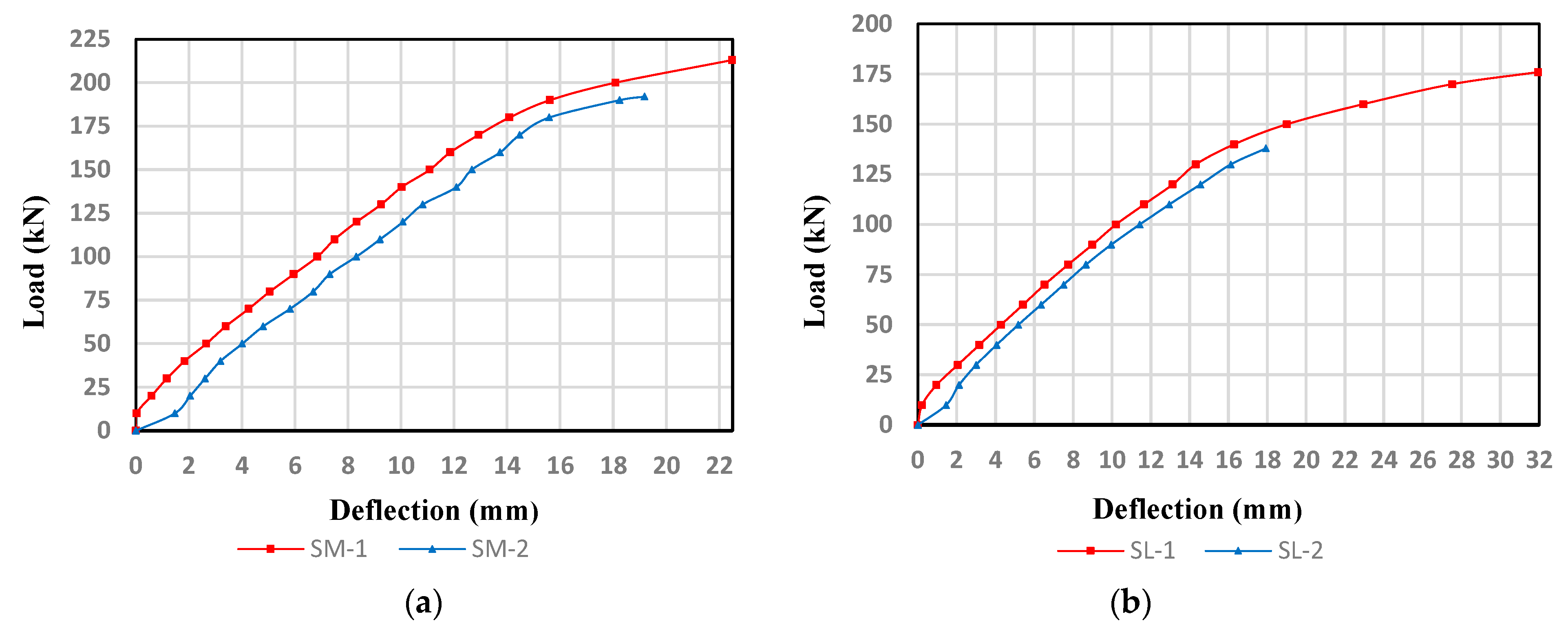
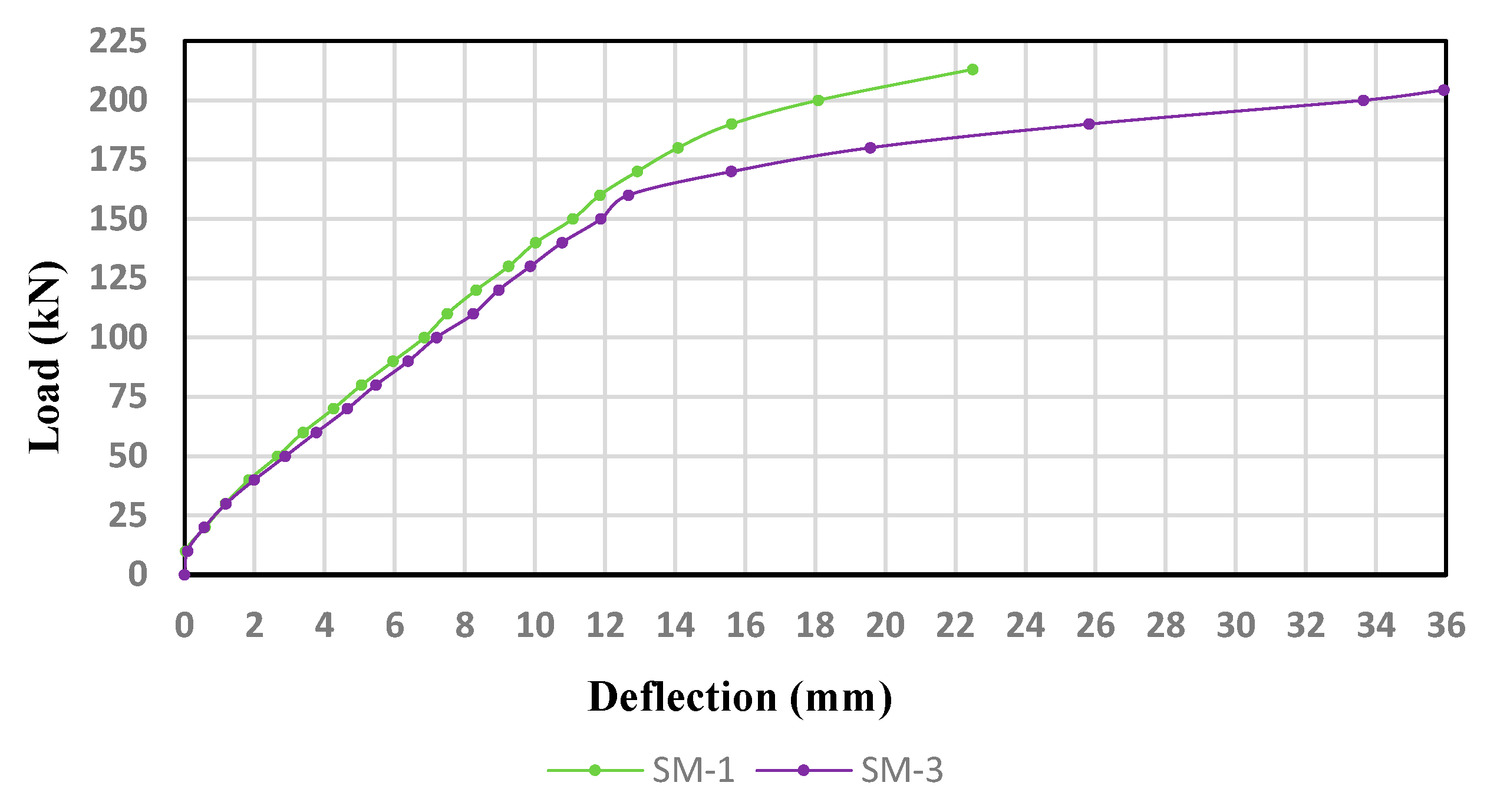
| Components | Concrete Class | ||
|---|---|---|---|
| H * | M * | L * | |
| Cement/OPC (kg) | 345 | 260 | 205 |
| Coarse aggregate (kg) | 380 | 365 | 365 |
| Medium aggregate (kg) | 630 | 590 | 590 |
| Silica sand (kg) | 635 | 700 | 750 |
| Crushed sand (kg) | 275 | 300 | 305 |
| Total water (kg) | 172 | 180 | 180 |
| 605 Superplasticizer (Type G) (kg) | 9.6 | 7.28 | 5.7 |
| W/C eff | 0.45 | 0.63 | 0.79 |
| Tensile Strength (MPa) | Elasticity Modulus (GPa) | Density of Carbon Fiber (g/cm3) | Width (mm) | Thickness (mm) | Strain at Break |
|---|---|---|---|---|---|
| 3100 | 165 | 1.6 | 15 | 2.5 | >1.70% |
| Density | Tensile Strength | Bond Strength | Elongation at Break | E-Modulus |
|---|---|---|---|---|
| 1.30 kg/lt ± 0.1 kg/lt (parts A+B mixed) | 30 MPa * | Concrete fracture > 4 MPa on sandblast substrate | 0.9% * | Flexural: 3800 MPa * |
| Tensile: 4500 MPa * |
| Test Groups | Beam Designations | Strengthening Schemes |
|---|---|---|
| Group H | CH | N/A |
| SH-1 | Two horizontal NSM-CFRP strips at full span length | |
| SH-2 | Two horizontal NSM-CFRP strips over the middle half of the span | |
| SH-3 | One horizontal NSM-CFRP strip at full span length | |
| Group M | CM | N/A |
| SM-1 | Two horizontal NSM-CFRP strips at full span length | |
| SM-2 | Two horizontal NSM-CFRP strips over the middle half of the span | |
| SM-3 | One horizontal NSM-CFRP strip at full span length | |
| Group L | CL | N/A |
| SL-1 | Two horizontal NSM-CFRP strips at full span length | |
| SL-2 | Two horizontal NSM-CFRP strips over the middle half of the span |
| Specimen | Ultimate Load, Pu (kN) | Deflection, Δ (mm) | Enhancement Ratio % | Strength Factor, |
|---|---|---|---|---|
| SF | ||||
| CH | 280 | 19.53 | --- | --- |
| SH-1 * | 300 | 24.44 | 7% | 1.07 |
| SH-2 | 310 | 21.21 | 10.72% | 1.11 |
| SH-3 | 309 | 26.33 | 10.36% | 1.1 |
| CM | 157 | 16.2 | --- | --- |
| SM-1 | 213 | 22.49 | 35.67% | 1.36 |
| SM-2 | 192 | 19.18 | 22.29% | 1.22 |
| SM-3 | 204.31 | 35.94 | 30% | 1.3 |
| CL | 116 | 6.7 | --- | --- |
| SL-1 | 176.65 | 31.95 | 52.28% | 1.52 |
| SL-2 | 138 | 17.93 | 19% | 1.19 |
| Specimen | Ultimate Moment, (Mu) | Ultimate Load, (Pu) | Error (%) | ||
|---|---|---|---|---|---|
| Mu, Exp. (kN·m) | Mu, Theo. (KN·m) | Pu, Exp. (kN) | Pu, Theo. (kN) | ||
| CH | 126 | 76.99 | 280 | 171.1 | 63.65 |
| SH-2 | 139.5 | 102.66 | 310 | 228.12 | 35.89 |
| SH-3 | 139.05 | 92 | 309 | 204.44 | 51.14 |
| CM | 70.65 | 60.1 | 157 | 133.55 | 17.56 |
| SM-1 | 95.85 | 84.08 | 213 | 186.84 | 14.00 |
| SM-2 | 86.4 | 84.08 | 192 | 186.84 | 2.76 |
| SM-3 | 91.94 | 74.62 | 204.31 | 165.82 | 23.21 |
| CL | 52.2 | 35.33 | 116 | 78.51 | 47.75 |
| SL-1 | 79.49 | 48.93 | 176.65 | 108.73 | 62.47 |
| SL-2 | 62.1 | 48.93 | 138 | 108.73 | 26.92 |
Publisher’s Note: MDPI stays neutral with regard to jurisdictional claims in published maps and institutional affiliations. |
© 2022 by the authors. Licensee MDPI, Basel, Switzerland. This article is an open access article distributed under the terms and conditions of the Creative Commons Attribution (CC BY) license (https://creativecommons.org/licenses/by/4.0/).
Share and Cite
Al-zu’bi, H.; Abdel-Jaber, M.; Katkhuda, H. Flexural Strengthening of Reinforced Concrete Beams with Variable Compressive Strength Using Near-Surface Mounted Carbon-Fiber-Reinforced Polymer Strips [NSM-CFRP]. Fibers 2022, 10, 86. https://doi.org/10.3390/fib10100086
Al-zu’bi H, Abdel-Jaber M, Katkhuda H. Flexural Strengthening of Reinforced Concrete Beams with Variable Compressive Strength Using Near-Surface Mounted Carbon-Fiber-Reinforced Polymer Strips [NSM-CFRP]. Fibers. 2022; 10(10):86. https://doi.org/10.3390/fib10100086
Chicago/Turabian StyleAl-zu’bi, Hebah, Mu’tasim Abdel-Jaber, and Hasan Katkhuda. 2022. "Flexural Strengthening of Reinforced Concrete Beams with Variable Compressive Strength Using Near-Surface Mounted Carbon-Fiber-Reinforced Polymer Strips [NSM-CFRP]" Fibers 10, no. 10: 86. https://doi.org/10.3390/fib10100086
APA StyleAl-zu’bi, H., Abdel-Jaber, M., & Katkhuda, H. (2022). Flexural Strengthening of Reinforced Concrete Beams with Variable Compressive Strength Using Near-Surface Mounted Carbon-Fiber-Reinforced Polymer Strips [NSM-CFRP]. Fibers, 10(10), 86. https://doi.org/10.3390/fib10100086





